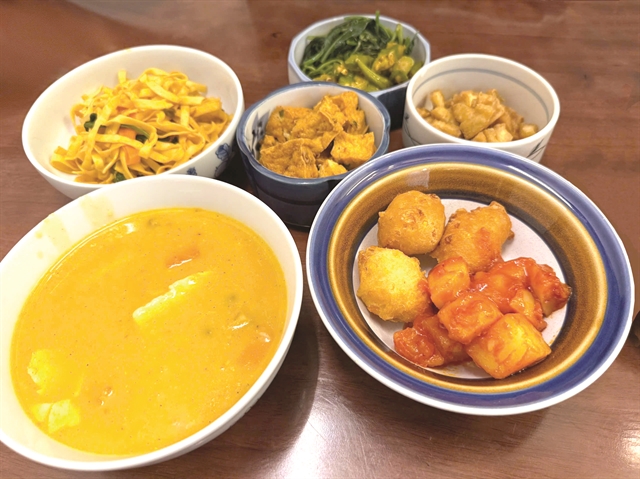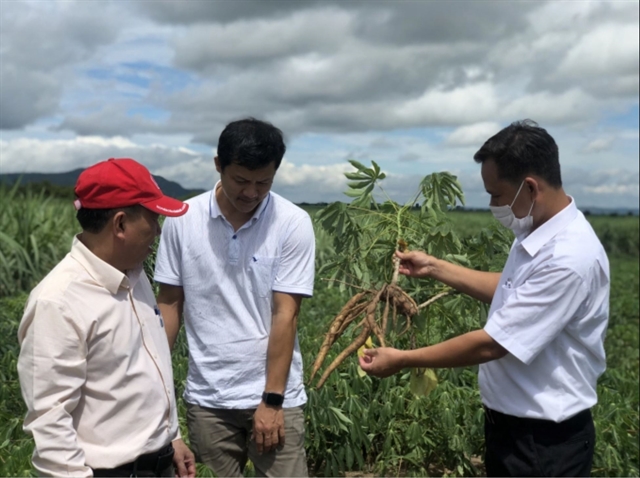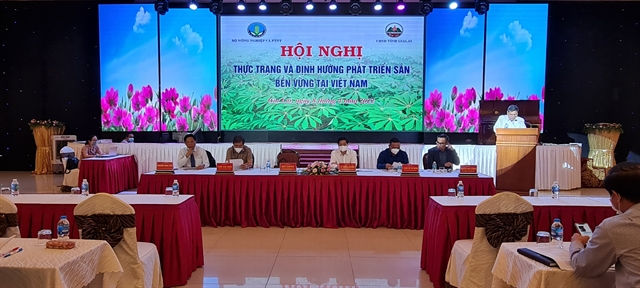 Economy
Economy


|
| Exports of cassava and cassava products currently account for about 70 per cent of total output with a turnover worth nearly US$1.2 billion. Photo nongnghiep.vn |
By Tố Như
HÀ NỘI Diversifying markets and taking advantage of free trade agreement (FTA) tariff quotas are solutions for the country’s cassava industry to boost exports and ensure sustainable development, a conference has heard.
Ranked second in global export turnover, cassava and cassava products are among Việt Nam’s 13 key agricultural export items making the country the world’s third largest exporter after Thailand and Cambodia.
The outstanding record of the Vietnamese cassava industry was highlighted at a recent conference held in the Central Highlands province of Gia Lai’s Pleiku City by the Ministry of Agriculture and Rural Development (MARD) in collaboration with Gia Lai provincial People's Committee.
The conference analysed the current situation and development orientation of the industry, while discussing solutions to promote the economic value of cassava.
Exports of cassava and cassava products currently account for about 70 per cent of total output with a turnover worth nearly US$1.2 billion.
However, the industry is facing obstacles in improving production and ensuring sustainable development.
The conference revealed many cassava factories, especially small-scale ones, are using low technologies, some of them are even outdated with no waste treatment measures. This has resulted in low investment efficiency and impacts on the environment.
Moreover, there are not many cassava varieties with high yield, good quality, high starch content and resistance capacity against the leaf mosaic disease.

|
| A recent conference held in the Central Highlands province of Gia Lai’s Pleiku City by MARD in collaboration with Gia Lai provincial People's Committee analysed the situation and development orientation of the cassava industry. VNA/VNS Photo Hồng Điệp |
From a market perspective, Nguyễn Quốc Toản, Director of the Department of Agricultural Product Processing and Market Development under MARD, said that coordination between cassava factories and farmers is not tight enough in both mechanisms and benefits.
Meanwhile, the purchasing methods and selling prices are not flexible so they are unable to encourage farmers to grow cassava, especially those in areas near factories, according to Toản.
Unstable export prices, weak export markets depending on foreign countries and a lack of protection policies for cassava farmers in remote areas are among obstacles facing the cassava industry, he said.
The Department of Crop Production (DCP) reported in 2021, the country's cassava growing area reached 528,000ha. The Central Highlands has the largest area with 172,500ha, accounting for 32.7 per cent of the country's total cassava area.
In 2021, the country's average yield stood at 20.3 tons/ha, with an output of nearly 10.7 million tons. Exports reached nearly 2.9 million tons, worth about $1.2 billion, up 2.4 per cent in volume and 16.5 per cent in value compared to 2020.
At present, 120 cassava starch processing factories are operating in 27 provinces with a total capacity of over 8.6 million tons of fresh tubers/year.
Standing Vice Chairman of the Việt Nam Cassava Association, Nghiêm Minh Tiến, said the industry’s development speed has seen a rapid increase in the last 10 years.
Cassava is the third most important food crop in Việt Nam after rice and maize, attracting 1.2 million growers, many of whom are from ethnic minorities.
Speaking at the conference, MARD Deputy Minister Lê Quốc Doanh affirmed the role of cassava, saying it not only helps alleviate local poverty but also has become a commodity crop.
To sustainably develop cassava in the future, Doanh suggested focusing on scientific research and promoting international cooperation to find disease-free and disease-resistant cassava varieties, thereby contributing to reducing input production costs.
"We have to do something to help farmers access those cassava varieties. I assign the Plant Protection Department to propose more production processes to create a chain of disease-free and disease-resistant cassava varieties," Doanh emphasised.
In addition, the MARD Deputy Minister said, cassava processing factories need to innovate technologies to diversify products, expand the material areas and thoroughly solve problems of waste treatment during production, ensuring environmental safety.
Linkages between growing areas and processing factories should be strengthened along with the reorganising of production focusing on developing cooperatives, according to Doanh.
“The DCP is assigned to coordinate with relevant units to develop a project on cassava production at the same time mobilise available local resources for sustainable development until 2030,” Doanh said.
Strong growth but challenges ahead
According to the General Department of Customs, cassava and cassava products were among the agricultural items maintaining a growth rate in both output and export turnover in the past year.
In the first months of 2022, after a decline in January and February, cassava and cassava product exports tended to increase again in March with an estimate of about 450,000 tons, worth US$202 million, up 80.6 per cent in volume and 97.1 per cent in value compared to February.
Total exports of cassava and cassava products in the first three months of 2022 were estimated at about 970,000 tons, worth US$420 million, down 0.6 per cent in volume, but increasing by 15.5 per cent in value compared to the same period in 2021.
However, experts warned of challenges for the industry to expand consumption in both domestic and world markets.
The domestic cassava market is speculative and has many intermediary stages, each of which involves many factors making it quite complicated and causing fierce competition in purchasing and selling.
Meanwhile, export markets are still limited, mainly depending on China which accounts for over 95 per cent of the total output. It has been also facing fierce competition from Thailand, Cambodia and Laos, especially in the context that China is increasing imports from Laos and Cambodia.
Depending almost entirely on the Chinese market is leading to unsustainable and passive development for the industry.
Việt Nam's national competition in the world market is still low because its cassava and cassava products have to depend on many intermediaries and logistics costs are higher than that of Thailand and China.
Another paradox raised by DCP Director Nguyễn Như Cường is about domestic consumption. Some 30 per cent of the total cassava output is for food processing, animal feed and input materials for other industries such as alcohol, monosodium glutamate, instant noodles and confectionery.
"In fact, we still have to import quite a lot of raw materials for animal feed and food processing," he said.
The Ministry of Industry and Trade’s Import-Export Department forecasts in 2022, mainland China will increase the demand of cassava and cassava products imported from Việt Nam. However, exports to mainland China will face difficulties because of a series of new regulations and standards applied by China’s General Administration of Customs from the beginning of 2022.
Currently, Việt Nam's cassava and cassava products are mainly exported to mainland China but more than 65 per cent of them are delivered through border gates in Lạng Sơn, Quảng Ninh and Lào Cai provinces.
The Import-Export Department recommends cassava exporters switch to the official export scheme.
Besides maintaining the market in mainland China, Toản suggested to focus more on expanding to large and demanding markets such as South Korea, Japan, and Taiwan.
Notably, according to the EU-Vietnam FTA, cassava starch is the second product granted tariff-free quota after rice, at 30,000 tons/year.
Việt Nam’s cassava industry currently has not taken advantage of such tariff quota opportunities to expand export markets to countries and regions that have signed FTAs in exports of cassava and cassava products, the official said. VNS